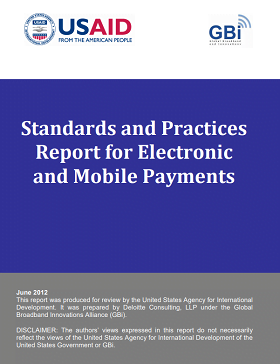Standards and Practices Report for Electronic and Mobile Payments
The benefits of new electronic and mobile payment methods in support of USAID objectives to better serve the unbanked have been well-documented in other literature, 2 and that case will not be reiterated in this report. A practical strategy for evaluating an individual program or Mission environment for suitability of payment type, however, has not yet been proposed or considered in a structured manner. The purpose of this report is to set a baseline understanding of available payment alternatives and to establish a framework for evaluating those alternatives in consideration of the unique environment and risk profile of individual USAID programs or Missions.
USAID’s policy-level support for the evaluation and adoption of electronic and mobile payments is somewhat fractured, with most adoption occurring at the Mission or program level. This is not surprising as the majority of electronic and mobile payment disbursements are being driven by USAID Implementing Partners, buoyed by the rapid development and proliferation of payment technology. USAID can play an active role in the evaluation of electronic and mobile payments for potential adoption as a facilitator and a broker between stakeholders at the Mission level, and as a supporter of standards and practices from headquarters.
The agency can also help Missions to determine if three important conditions exist when considering the adoption of electronic or mobile payments. First, at least one reliable payment provider must be operating in the local environment. Second, there must be an appropriate regulatory environment for payment transactions, at least the existence of a local government regulatory body that is able to support the creation of such an environment, or, in the absence of such a regulatory environment, sufficient internal controls on the part of the provider to compensate for the lack of government regulation or guidelines. Lastly, there must be sufficient reach among Payment Beneficiaries in the target market for alternatives to cash payments
Under these conditions, USAID is increasingly in a position to promote electronic and mobile payments expansion. The objective of this report is to provide a baseline understanding of:
- Existing and emerging payment types
- The regulatory environment and internal controls that govern payment transactions and payment providers
- The risk profiles of each payment type
- Strategies for risk mitigation related to each payment type
Using this analysis, the report provides an assessment framework that USAID can leverage to assist Missions and Implementing Partners when evaluating local environments with regard to the aforementioned conditions. This evaluation framework is a tool that will enable decision-makers to create a risk profile for available payment types as a means to select a proposed payment method. This analysis includes an assessment of project-level risk tolerance based on program objectives, and the balancing of program goals related to serving a Payment Beneficiary population against risks of payment failure.



